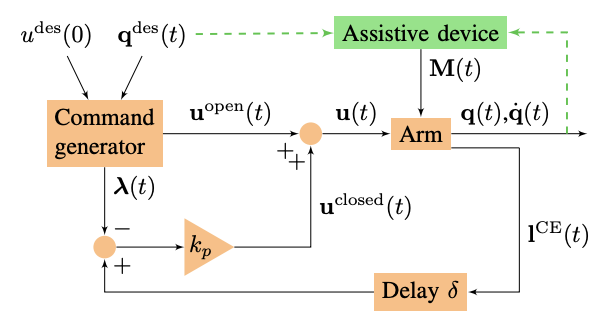Simulating the response of a neuro-musculoskeletal model to assistive forces: implications for the design of wearables compensating for motor control deficits

Models of the human arm may help to estimate design parameters like peak torque and power of wearable assistive devices by predicting required forces to compensate for motor control impairments. This work focuses on the idea of compensating hypermetria (overshoot)-a motor control deficit that may occur in neurodegenerative diseases-by a simple assistive device. As musculoskeletal dynamics play an important role in the interaction between an assistive device and the neuro-musculoskeletal system, we hypothesized that their consideration in the model might influence the predicted design parameters. To test this, we simulated two-degree-of-freedom point-to-point arm movements. By introducing inconsistent neuronal control parameters, we induced hypermetria. We implemented mechanical and low-level assistive torque strategies in simulation which lead to a reduction of hypermetria. We found that-depending on the type of assistance-the predicted torques and powers can differ by more than a factor of 10 between musculoskeletal and torque-driven arm models. We conclude that the magnitude of torque and power required to reduce hypermetria by simple wearable assistive devices may be significantly underestimated if muscle-tendon characteristics are not considered.
| Author(s): | Katrin Stollenmaier and Ilka Rist and Fabio Izzi and Daniel F.B. Haeufle |
| Book Title: | 2020 8th IEEE RAS/EMBS International Conference for Biomedical Robotics and Biomechatronics (BioRob 2020) |
| Pages: | 779--784 |
| Year: | 2020 |
| Month: | October |
| Day: | 15 |
| Publisher: | IEEE |
| Bibtex Type: | Conference Paper (inproceedings) |
| Address: | Piscataway, NJ |
| DOI: | 10.1109/BioRob49111.2020.9224411 |
| Event Name: | 8th IEEE RAS/EMBS International Conference for Biomedical Robotics and Biomechatronics (BioRob 2020) |
| Event Place: | New York, NY |
| State: | Published |
| Electronic Archiving: | grant_archive |
| ISBN: | 978-1-7281-5907-2 |
BibTex
@inproceedings{biorob,
title = {Simulating the response of a neuro-musculoskeletal model to assistive forces: implications for the design of wearables compensating for motor control deficits},
booktitle = {2020 8th IEEE RAS/EMBS International Conference for Biomedical Robotics and Biomechatronics (BioRob 2020)},
abstract = {Models of the human arm may help to estimate design parameters like peak torque and power of wearable assistive devices by predicting required forces to compensate for motor control impairments. This work focuses on the idea of compensating hypermetria (overshoot)-a motor control deficit that may occur in neurodegenerative diseases-by a simple assistive device. As musculoskeletal dynamics play an important role in the interaction between an assistive device and the neuro-musculoskeletal system, we hypothesized that their consideration in the model might influence the predicted design parameters. To test this, we simulated two-degree-of-freedom point-to-point arm movements. By introducing inconsistent neuronal control parameters, we induced hypermetria. We implemented mechanical and low-level assistive torque strategies in simulation which lead to a reduction of hypermetria. We found that-depending on the type of assistance-the predicted torques and powers can differ by more than a factor of 10 between musculoskeletal and torque-driven arm models. We conclude that the magnitude of torque and power required to reduce hypermetria by simple wearable assistive devices may be significantly underestimated if muscle-tendon characteristics are not considered.},
pages = {779--784},
publisher = {IEEE},
address = {Piscataway, NJ},
month = oct,
year = {2020},
slug = {biorob},
author = {Stollenmaier, Katrin and Rist, Ilka and Izzi, Fabio and Haeufle, Daniel F.B.},
month_numeric = {10}
}
